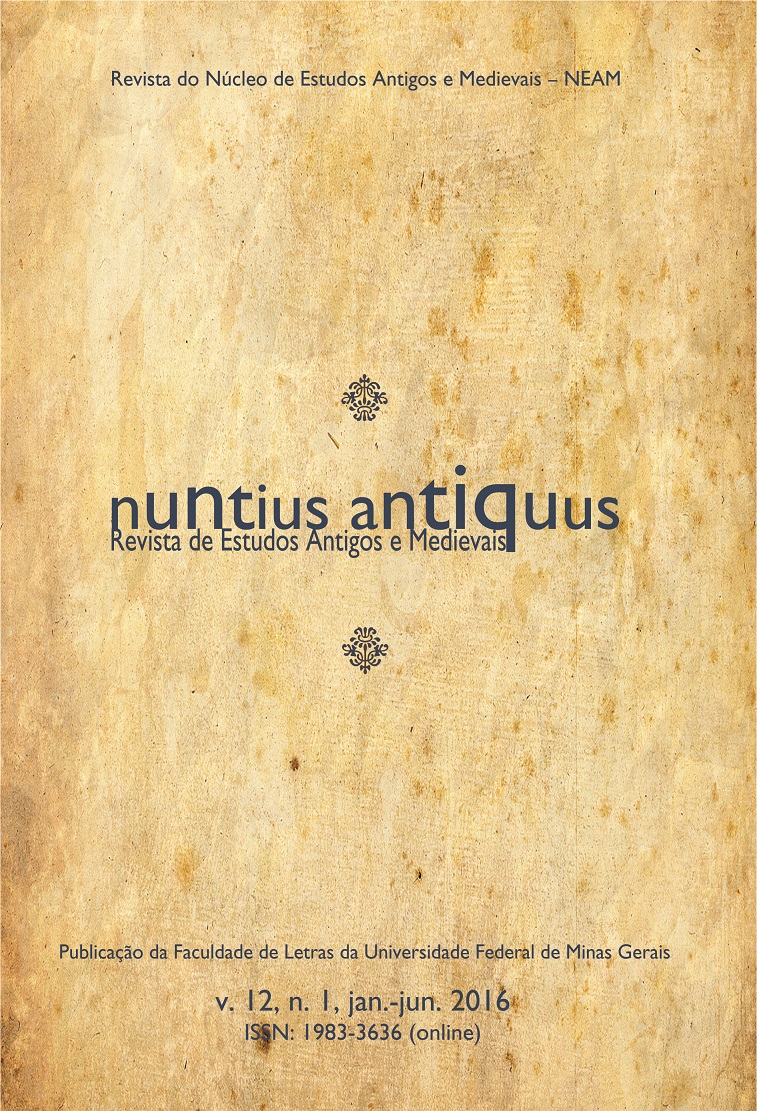Helen’s semiotic body
ancient and modern representations
DOI:
https://doi.org/10.17851/1983-3636.12.1.187-213Palavras-chave:
Edmund Burke, Helen, Iliad, female body and male gaze, Homer on filmResumo
The paper draws on theoretical work on the representation of the female body as an object of the male gaze in modern narrative, in order to decode and analyze Helen’s portrayal as a physical vacuum in ancient literature. I argue that the negation of Helen’s corporeality emphasizes the semiotic duality of her body, allowing it to be deployed both as a sign and as a site for the inscription of signs. The paper, then, proceeds to show how Helen’s Iliadic depiction has provided the eighteenth-century philosopher Edmund Burke with a rhetorical platform upon which to theorize the aesthetic dichotomy between the beautiful and the sublime. I close my analysis by illustrating how the eclecticism, compromises, and pastiches that inform Helen’s cinematic recreations find a parallel in, and thus perpetuate, ancient pictorial techniques.
Referências
AUSTIN, N. Helen of Troy and her shameless phantom. Ithaca: Cornell University Press, 1994.
BARKER, F. The tremulous private body: essays on subjection. Ann Arbor: The University of Michigan Press, 1995.
BARTON, R. Hedy Lamarr: the most beautiful woman in film. Lexington: The University Press of Kentucky, 2010.
BECKER, A. S. The shield of Achilles and the poetics of Ekphrasis (Greek Studies: Interdisciplinary Approaches). Lanham, MA: Rowman & Little Eld Publishers, 1995
BERTI, I.; GARCÍA MORCILLO, M. introduction: Does Greece and the cinema – need a new Alexander? In: ______. (Ed.). Hellas on screen: cinematic receptions of ancient history, literature and myth. Stuttgart: Franz Steiner Verlag, 2008. p. 9-20.
BLONDELL, R. “Bitch that I Am”: self-blame and self-assertion in the Iliad. Transactions of the American Philological Association, Baltimore, v. 140, n.1, p. 1-32, 2010.
BLONDELL, R. Helen of Troy: beauty, myth, devastation. Oxford: Oxford University Press, 2013.
BROMWICH, D. The intellectual life of Edmund Burke: from the sublime and beautiful to American Independence. Cambridge, MA: The Belknap Press of Harvard University Press, 2014.
BROOKS, P. Body work: objects of desire in modern narrative. Cambridge, MA: Harvard University Press, 1993.
BURKE, E. A Philosophical enquiry into the origin of our ideas of the sublime and beautiful. Edited with introduction and Notes by James T. Boulton. New York: Columbia University Press, 1958.
CLADER, L. L. Helen: the evolution from divine to heroic in Greek epic tradition. Leiden: Brill, 1976.
CYRINO, M. S. Aphrodite (Gods and Heroes of the Ancient World). New York: Routledge, 2010.
EDMUNDS, L. Stealing Helen: the myth of the abducted wife in comparative perspective. Princeton: Princeton University Press, 2015.
ELDRIDGE, D. Hollywood’s history films. New York: i.B. Tauris, 2006. FORD, E.; MITCHELL, D. C. Royal portraits in Hollywood: filming the lives of queens. Lexington: The University Press of Kentucky, 2009.
FULKERSON, L. The Ovidian heroine as author: reading, writing, and community in the Heroides. Cambridge: Cambridge University Press, 2005.
HALL, E. Inventing the barbarian: Greek self-definition through tragedy. Oxford: Oxford University Press, 1989.
ISENBERG, N. Edgar G. Ulmer: a fimmaker at the margins. Berkeley and Los Angeles: University of California Press, 2014.
KONSTAN, D. Beauty: the fortunes of an ancient Greek idea. Oxford: Oxford University Press, 2014.
KROHN, B. The naked filmmaker. In: HERZOGENRATH, B. (Ed.). The films of Edgar G. Ulmer. Lanham, MD: Scarecrow Press, 2009. p. 175-192.
LAMARR, H. Ecstasy and me: my life as a woman. New York: Bartholomew House, 1966.
MAGUIRE, L. Helen of Troy: from Homer to Hollywood. Malden, MA: Wiley-Blackwell, 2009.
MANSFIELD, E. C. Too beautiful to picture: Zeuxis, myth, and mimesis. Minneapolis: University of Minnesota Press, 2007.
MARTINS, P. Constructing Cicero. Nuntius Antiquus, Belo Horizonte, v. 9, n. 2, p. 221-237, 2013.
McCLURE, L. Spoken like a woman: speech and gender in Athenian drama. Princeton: Princeton University Press, 1999.
NEGRA, D. Off-White Hollywood: American culture and ethnic female stardom. New York: Routledge, 2001.
NIKOLOUTSOS, K. P. From text to screen: celluloid Helens and female stardom in the 1950s. The Cambridge Classical Journal, Cambridge, v. 61, p. 70-90, 2015.
NISBET, G. Ancient Greece in film and popular culture. Exeter: Bristol Phoenix Press, 2006.
NORMAN, J. Edmund Burke: the first conservative. New York: Basic Books, 2013.
ORMAND, K. The Hesiodic catalogue of women and archaic Greece. Cambridge: Cambridge University Press, 2014.
PALMER, A. P. Ovidi Nasonis Heroides. Final editing by L. Purser. Oxford: Oxford University Press, 1898.
RYAN, C. Burke’s classical heritage: playing games with Longinus. In: VERMEIR, K.; DECKARD, M. F. (Ed.). The science of sensibility: reading Burke’s philosophical enquiry. New York: Springer, 2012. p. 225-245. (International Archives of the History of Ideas, v. 206).
SCODEL, R. Epic framework: self-representation and social interaction in Homer. Swansea: The Classical Press of Wales, 2008.
SHAW, P. The sublime. New York: Routledge, 2006.
SHEARER, S. M. Beautiful: the life of Hedy Lamarr. Forwarded by Robert Osborne. New York: St. Martin’s Press, 2010.
VIVANTE, B. Gazing at Helen: Helen as Polysemous icon in Robert Wise’s Helen of Troy and Michael Cacoyannis’ The Trojan Women. In: NIKOLOUTSOS, K. P. (Ed.). Ancient Greek women in film. Oxford: Oxford University Press, 2013. p. 19-50.
WINKLER, M. M. Cinema and classical texts: Apollo’s new light. Cambridge: Cambridge University Press, 2009.
ZIOGAS, I. Ovid and Hesiod: the metamorphosis of the catalogue of women. Cambridge: Cambridge University Press, 2013.
Downloads
Publicado
Edição
Seção
Licença
Copyright (c) 2016 Konstantinos P. Nikoloutsos

Este trabalho está licenciado sob uma licença Creative Commons Attribution 4.0 International License.










